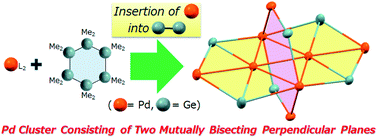Discrete palladium clusters that consist of two mutually bisecting perpendicular planes†
Abstract
The construction of novel molecules with unprecedented alignments of the constituent elements has revolutionized the field of functional materials. The arrangement of two or more planar subunits in a mutually perpendicular fashion is a frequently encountered approach to produce novel functional materials. Previous examples of such materials can be categorized into two well-investigated families: spiro-conjugated and dumbbell-shaped structures, wherein the two planes are aligned orthogonally via a single atom or an axis, respectively. This article describes a third family: reaction of [Pd(CNtBu)2]3 with Sn3Me8 or Ge6Me12 afforded a Pd7Sn4 cluster and a Pd8Ge6 cluster that consist of two mutually bisecting perpendicular planes. In the Pd7Sn4 cluster, the two equivalent Pd5Sn2 planes share three palladium atoms that include a dihedral angle of 85.6°.



 Please wait while we load your content...
Please wait while we load your content...